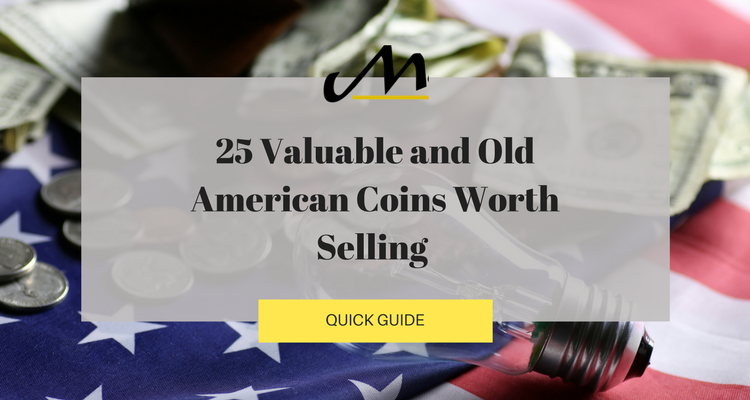
How do you know if your old coins are valuable and worth selling?
If you’re a collector of anything — cars, books, records, or knick-knacks — you know just because something is old, doesn’t mean it’s always worth money. And coins are no exception.
Some silver dollars are worth a buck, while others could be worth millions. Many of the criteria have to do with precious metal value, historical significance, rarity, or errors. We often see numismatic coins or coins with a collector’s value above the precious metal content. But most of our customers bring in coins with precious metal value.
To determine the precious metal value of a coin, you only need to know the following:
- weight of the coin (in grams or pennyweight)
- purity of the coin (how much gold or silver it contains)
- current spot market price (which you can see here)
For example, if your coin is still in circulation and backed by the government, you could always spend it for its face value. A 1966 quarter is still worth 25 cents. You could use it to scratch a lottery ticket…or buy ¼ of a candy bar. It doesn’t have any precious metal value.
But, let’s say you have a quarter that’s just a little bit older. If it was minted in 1964, it has 90% silver in it. You could sell it for $2. Or two items from McDonald’s dollar menu.
In comparison, if you have a $20 Walking Liberty, you could splurge a little at Target. Or, trade it in for its gold value and get over $1000! Yeah, gold is worth much more than silver.
In short, it pays to take a closer look at your old coins to see if they’re rare or have precious metal value. That’s why we created this quick guide.
Compare the list below to any old coins you have around your house (or in the swear jar). If you find a match, give us a call and we can give tell you what your coin is worth on the market today!
A List of Valuable or Rare American Coins You Can Sell
SILVER U.S COINS
| COIN | DATES MINTED | COMPOSITION | WEIGHT |
| Barber Dime | 1892-1916 | 90% silver; 10% copper | 1.61 dwt |
| Mercury Dime | 1916-1945 | 90% silver; 10% copper | 1.61 dwt |
| Roosevelt Dime | 1946-1964 | 90% silver; 10% copper | 1.61 dwt |
| Barber Quarter | 1892-1916 | 90% silver; 10% copper | 4.02 dwt |
| Standing Liberty Quarter | 1916-1930 | 90% silver; 10% copper | 4.02 dwt |
| Washington Quarter | 1932-1964 | 90% silver; 10% copper | 4.02 dwt |
| Barber Half Dollar | 1892-1915 | 90% silver; 10% copper | 8.04 dwt |
| Walking Liberty Half Dollar | 1916-1947 | 90% silver; 10% copper | 8.04 dwt |
| Franklin Half Dollar | 1948-1963 | 90% silver; 10% copper | 8.04 dwt |
| Kennedy Half Dollar | 1964 | 90% silver; 10% copper | 8.04 dwt |
| Kennedy Half Dollar | 1965-1970 | 40% silver; 60% copper | 8.04 dwt |
| Trade Dollar | 1873-1885 | 90% silver; 10% copper | 17.5 dwt |
| Morgan Dollar | 1878-1921 | 90% silver; 10% copper | 17.5 dwt |
| Peace Dollar | 1921-1935 | 90% silver; 10% copper | 17.5 dwt |
| Eisenhower Silver Dollar | 1971-1978 | 40% silver; 60% copper | 24.59 grams |
GOLD U.S. COINS
| COIN | DATES MINTED | COMPOSITION | WEIGHT |
| $1 Liberty Head | 1849-1854 | 90% gold | 1.08 dwt |
| $1 Indian Head | 1854-1856 | 90% gold | 1.08 dwt |
| $2.50 Indian Head | 1840-1907 | 90% gold | 2.69 dwt |
| $2.50 Liberty Head | 1908-1929 | 90% gold | 2.69 dwt |
| $3 Indian Head | 1854-1889 | 90% gold | 3.22 dwt |
| $5 Liberty Head | 1839-1908 | 90% gold | 5.37 dwt |
| $5 Indian Head | 1908-1929 | 90% gold | 5.37 dwt |
| $10 Liberty Head | 1838-1908 | 90% gold | 10.74 dwt |
| $10 Indian head | 1907-1933 | 90% gold | 10.74 dwt |
| $20 Liberty Head | 1849-1907 | 90% gold | 21.50 dwt |
** Please note there may be slight variations in coin weight due to wear and tear.
